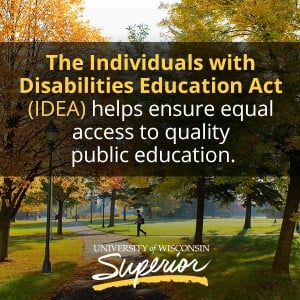Special education laws in the United States are quite complex. The Education for All Handicapped Children Act of 1975 and its reauthorization as the Individuals with Disabilities Education Act (IDEA) of 1990 set forth nationwide regulations and guidelines for special education. This legislation delegates much of the responsibility for implementation to state-based departments of education. Specific methods of initial student evaluation and implementation of other state directives are often further delegated to Local Education Agencies (LEAs) in state school districts. Special Education teachers and administrators therefore have to learn the intricacies of all these laws at the national, state and local levels.
Because of this, the University of Wisconsin-Superior’s Master of Science in Education — Special Education Online degree program includes extensive coursework in the many facets and implications of IDEA as well how its principles are implemented through the program design, mandates, and licensure requirements of Wisconsin’s Department of Instruction (DPI). Through this master’s degree program in special education, Wisconsin teachers can develop an understanding of special education law.

What Are the Basic Components of the Individuals With Disabilities Act?
The United States Congress passed IDEA with the intention of ensuring students with disabilities have equal access to quality public education. These laws uphold the educational rights of students with disabilities and mandate certain aspects of the individualized design of those students’ educational plans.
Free and Appropriate Education and the Least Restrictive Environment
These are the two basic principles of IDEA. School systems nationwide must provide each student with Free and Appropriate Public Education (FAPE), meaning that students with disabilities must receive a full, quality education regardless of their disability. Their education must also be appropriate to their specific needs, making accommodation for their disabilities wherever necessary.
The intent of the Least Restrictive Environment is to ensure students with disabilities receive the same high standard of education as all other students and participate in the general education classroom to whatever extent possible. The U.S. Department of Education (DoED) states simply “… special classes, separate schooling, or other removal of children with disabilities from the regular educational environment occurs only when the nature or severity of the disability of a child is such that education in regular classes with the use of supplementary aids and services cannot be achieved satisfactorily.”
The Individualized Education Program
When an evaluation deems a student sufficiently disabled for special needs education, a team of school personnel, special education specialists and that child’s parents or guardians convenes to devise an Individualized Education Program (IEP). This legal document spells out the educational plan for each student. The IEP incorporates parent and teacher input, including educational goals, accommodations to support LRE and inclusion in the general classroom, evaluative procedures, and other such aspects of the student’s education.
Beyond these basic tenants, IDEA further regulates and addresses many other aspects of special education programs, such as evaluative procedures for induction into special education services, procedures to ensure parental and student rights, confidentiality, disciplinary methods appropriate to each student, and transition services leading up to that student’s college and career life after school.
What Aspects of Special Education Law Are Delegated to State Education Departments and Local Education Agencies?
Although IDEA presents extensive laws and guidelines for the education of students with disabilities, much of the implementation of these laws is left up to the state and LEA. This is not to say that states do not need to follow the rules and structure set forth by IDEA; they are merely given autonomy as to many of the specifics of how they carry out these regulations. In general, this means that states must institute evaluative procedures, set up IEPs for students, and meet all the minimum requirements of FAPE, the LRE, transition services, and all other mandated aspects of IDEA.
But states can, and often do, go much further than IDEA law. For instance, although IDEA only requires states to offer special education services until students are 21, some states extend the age limit for these services. States and even specific school districts also have a great deal of purview with evaluation procedures, such as how specific learning disabilities are defined and how quickly evaluations are conducted after parents give consent to the process (as long as all of these policies are determined to be even better than the federal minimum).
States often also conform IDEA requirements to align with statewide educational program design and mission as well as student achievement assessment standards and teacher evaluative procedures. For instance, the Wisconsin DPI State Performance Plan aligns its special education design with the principles of its statewide commitment to “Every Child A Graduate” — a framework designed by the Alliance for Excellent Education to ensure every child graduates secondary school prepared to succeed in college and career alike.
Clearly, U.S. special education law is complicated yet necessary to ensure a quality education for all students. Developing an in-depth knowledge of federal special education laws as well as the intricacies of how those laws are interpreted and implemented at the state and local levels is essential to becoming an effective special education teacher or administrator in today’s schools.
Learn more about the UW-Superior online MSE Special Education program.
Sources:
U.S. Department of Education: Building the Legacy: IDEA 2004
Understood for Learning & Attention Issues: Special Education: Federal Law vs. State Law
Alliance for Excellence Education: From No Child Left Behind to Every Child a Graduate
Wisconsin Department of Public Instruction: Every Child a Graduate
Wisconsin Department of Public Instruction: Wisconsin’s State Performance Plan
Understood for Learning & Attention Issues: Understanding Individualized Education Programs


